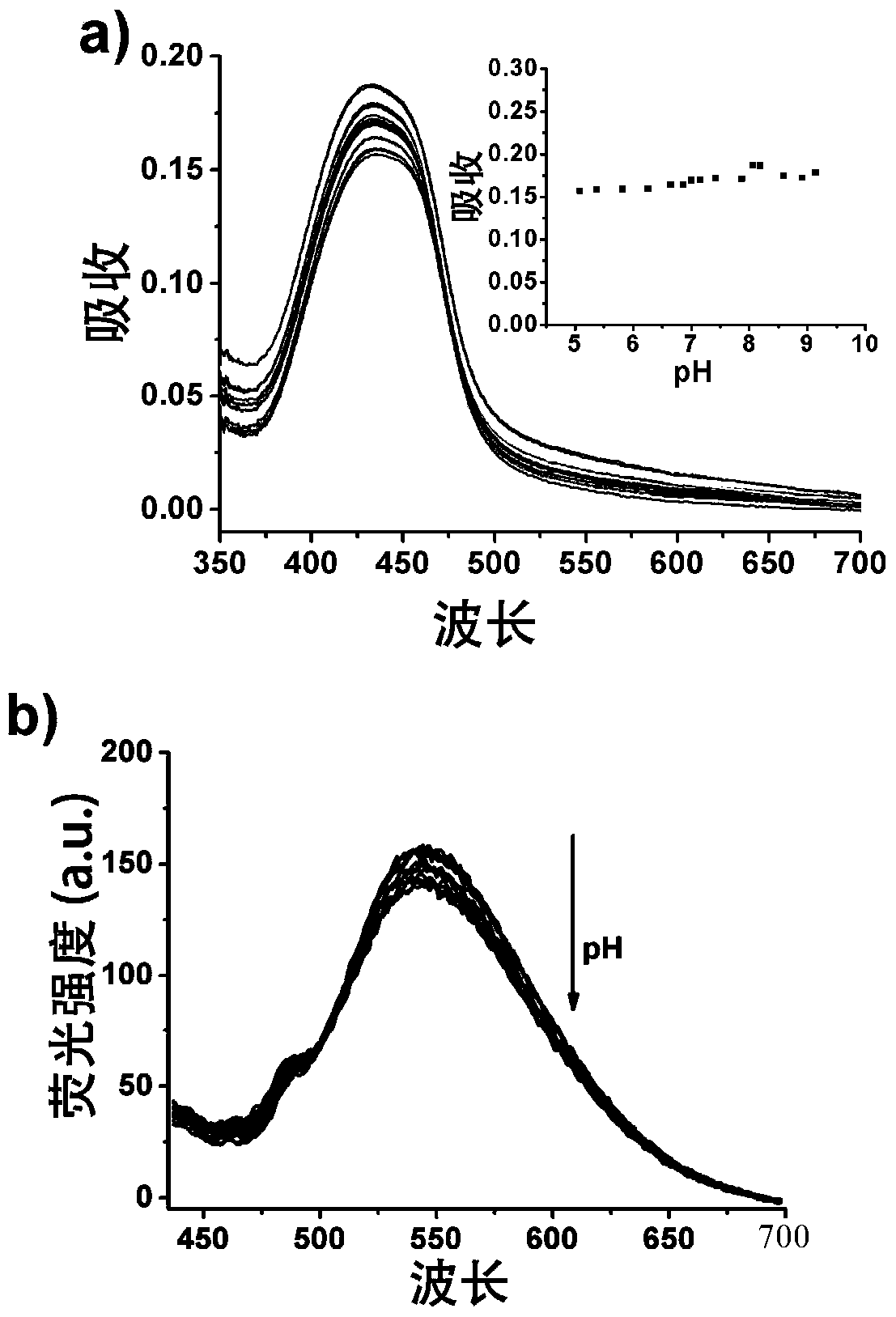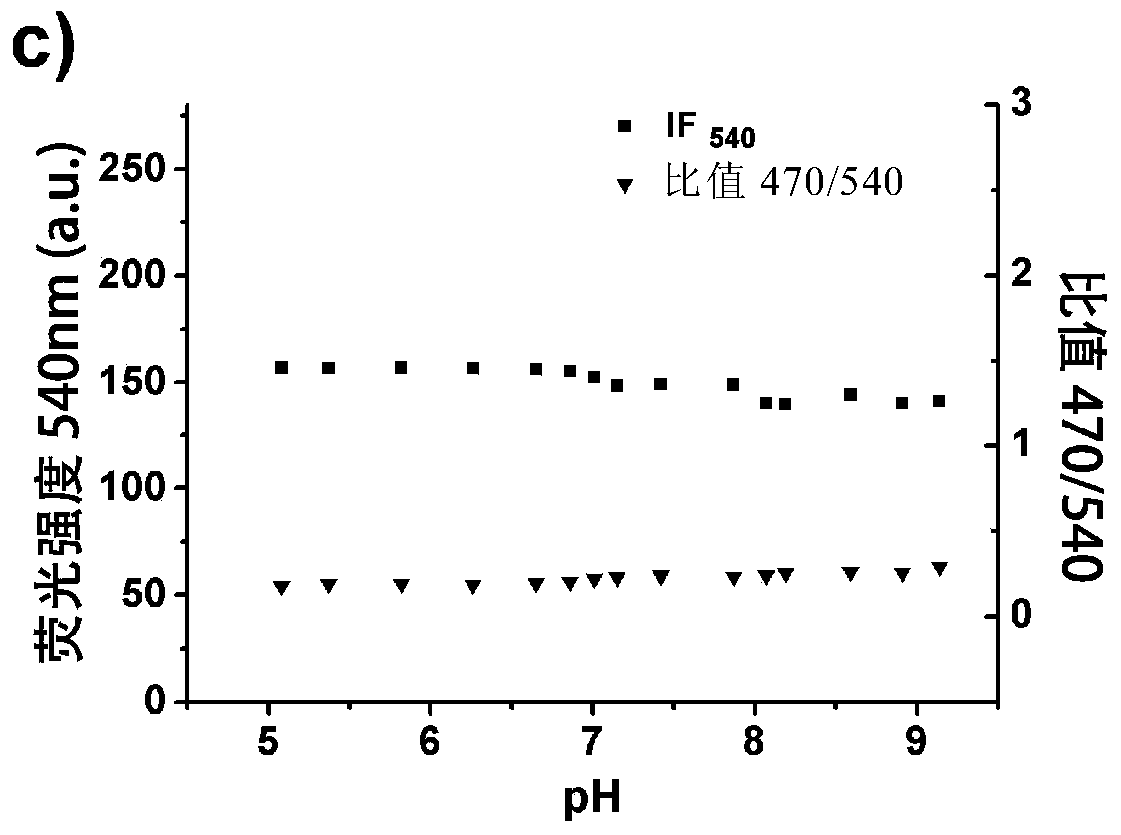A kind of high selectivity ratio type fluorescent probe and its application
An oxidative stress and compound technology, applied in the field of fluorescent probes, can solve the problem of not being able to use adjacent thiols of proteins
- Summary
- Abstract
- Description
- Claims
- Application Information
AI Technical Summary
Problems solved by technology
Method used
Image
Examples
Embodiment 1
[0069] The synthesis of target probes using 7-aminocoumarin and 1,8-naphthoimide as energy donors and acceptor fluorophores is as follows:
[0070]
[0071] PAO: p-aminophenylarsine (10.85g, 50mmol) was dissolved in methanol, heated to reflux to make the solution clear, then phenylhydrazine (10.30mL, 100mmol) was added dropwise, and the addition was completed in 10 minutes. A large amount of nitrogen gas was generated, and when the nitrogen gas became low, the reflux was continued for 1 hour. The reaction solution was concentrated at 90°C, 85mL of water and 0.1M aqueous sodium hydroxide solution (85mL) were added, washed with diethyl ether (2×75mL), and aqueous ammonium chloride solution (1M, 40mL) was added to the aqueous phase, placed in a refrigerator at 0°C to crystallize a large amount of White needle-like crystals of p-aminophenylarsine oxide were vacuum-dried to obtain 5.54 g of the product (yield 53%). Stored in KOH filled with Ar gas.
[0072] VTAF1: VTA1 (129mg,...
Embodiment 2
[0080] Embodiment 2: target probe pH titration test
[0081] pH titration experiments with target probes. Test solution pH with Sartorius basic pH-Meter PB-20, take probe stock solution 10 -3 M 200 μL was diluted into 20 mL of ultrapure aqueous solution to obtain 10 -5M probe aqueous solution. Use 2N hydrochloric acid and 1N NaOH solution to adjust the pH, and take a reading after the value in the pH meter is stable for 30 seconds. Then take 3mL solution in the cuvette with VarianCary 100 UV-visible spectrophotometer and Varian Cary Eclipse fluorescence photometer for absorption and emission spectrum testing. The pH titration curve of the target probe was obtained by fitting the maximum absorption value and emission value to the pH value in origin. From this it is possible to read out the optimal pH window where the probe is suitable for the application. see results figure 2 , under physiological conditions (pH7.4 or so), the probe can not be affected by external condit...
Embodiment 3
[0083] Using fluorescence ratio detection technology and electrophoresis to carry out the in vitro test of adjacent thiol proteins, using reduced bovine serum albumin (rBSA) as a model protein, and the probe VTAF synthesized in the examples as a small molecule fluorescent probe, the selective , concentration gradient and kinetic tests.
[0084] 1. Test the selectivity of the probe for adjacent thiol proteins
[0085] Using 40 μM microcuvettes, the probe was diluted to 1 μM, and various chemicals and proteins containing different thiol forms were added. The test temperature was controlled at 37° C. by water bath circulation, and the excitation wavelength was 405 nm. Use the Scan module in the Varian CaryEclipse fluorescence photometer for spectral testing, and the obtained fluorescence data can be fitted and calculated in origin as needed. The result is as Figure 4 shown. It can be seen from the figure that the probe VTAF does not respond to various amino acids, especially...
PUM
 Login to View More
Login to View More Abstract
Description
Claims
Application Information
 Login to View More
Login to View More - R&D
- Intellectual Property
- Life Sciences
- Materials
- Tech Scout
- Unparalleled Data Quality
- Higher Quality Content
- 60% Fewer Hallucinations
Browse by: Latest US Patents, China's latest patents, Technical Efficacy Thesaurus, Application Domain, Technology Topic, Popular Technical Reports.
© 2025 PatSnap. All rights reserved.Legal|Privacy policy|Modern Slavery Act Transparency Statement|Sitemap|About US| Contact US: help@patsnap.com



